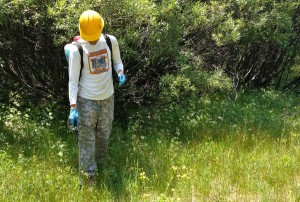USFS using herbicides to kill invasive weeds
By Kathryn Reed
U.S. Forest Service employees are using three herbicides now through September to rid the Lake Tahoe Basin of invasive weeds.
The chemical treatment will cover about 12½ acres in nearly 70 locations.
“This is part of a continuing terrestrial invasive plant treatment project since 2011. Most infestations that have been chemically treated exhibited greatly reduced quantities of invasive plants in following years. Many now have no plants at all,” Courtney Rowe, forest botanist, told Lake Tahoe News. “This is part of a larger ‘early detection, rapid response’ invasive plant management strategy, in which the LTBMU tries to eradicate or control certain priority invasive species that have high ecological impacts but currently exist at a low number of infestations before these species spread to a point that their eradication/control is unfeasible.”
The plants the Forest Service is trying to eradicate are whitetop, Dalmatian toadflax, yellow toadflax, hoary cress and Canada thistle.
Rodeo, Milestone, and Telar are the products that will be applied via backpack sprayers and other handheld tools.
The agency conducted an environmental analysis in 2010 that addressed safety concerns.
“That analysis states that the project’s control methods would pose little safety risk to workers or the public as long as safety practices and resource protection measures are enforced,” Rowe said.
Rowe said the drought tends to make plants flower sooner, but there is no evidence there are more of them.
The problem with the invasive non-natives is that they can overrun native species, which leads to their disappearance. This can then impact wildlife, cause erosion problems, which then impairs waterways.
The project areas include: the 64 Acres parking lot, Angora Fire area, Baldwin Beach meadow, Burke Creek trail, Luther Pass campground, Heavenly Creek Meadow, Heavenly Mountain Resort, Rabe Meadow, Lower Truckee River below Tahoe City, and Spooner Summit fire station.
Weed infestations on Forest Service urban lots will be treated near: Ralph Drive, Terry Lane, Ski Run Boulevard, and Mt. Rainier Drive in South Lake Tahoe, Sugar Pine Drive in Incline Village, Marge Court in Zephyr Cove, and Pine Street on Kingsbury Grade.
During spraying, caution signs will be posted for at least 48 hours after treatment. Orange and black caution tape will mark the boundary around each treatment area. Rowe said most of the areas are small, and some include targeting less than a handful of plants.
